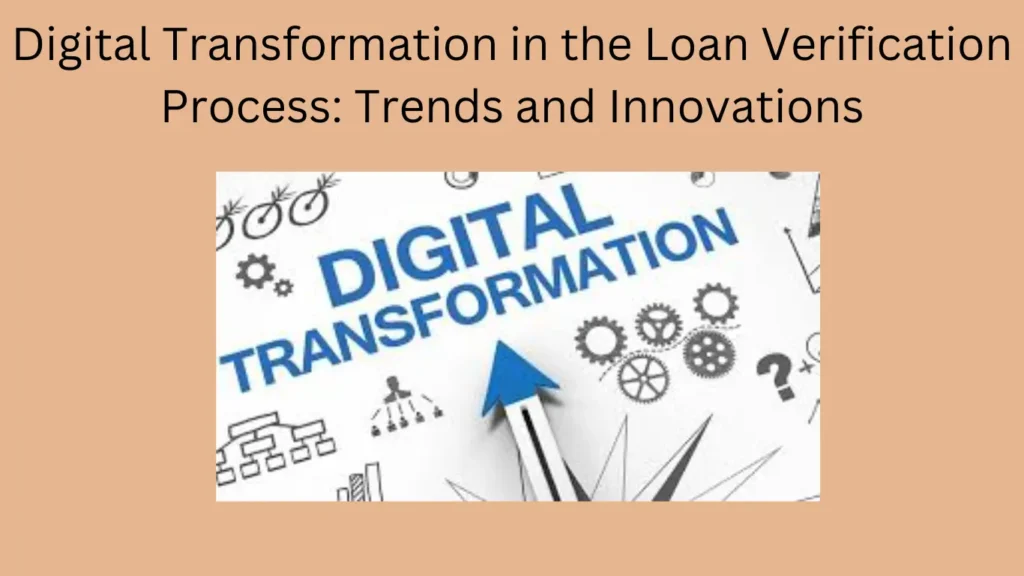The financial industry has experienced a significant shift towards digital transformation, and the loan verification process is no exception. Advances in technology have revolutionized how loans are verified, making the process faster, more efficient, and more user-friendly. Here’s a look at the trends and innovations shaping the digital transformation of loan verification.
1. Automated Verification Systems
What It Is
Automated verification systems use advanced algorithms and artificial intelligence (AI) to validate borrower information, such as income, employment, and identity, in real-time.
Benefits
- Speed: Automation significantly reduces the time required for verification.
- Accuracy: Reduces human error and ensures consistent application of verification criteria.
- Convenience: Borrowers can submit documents and receive responses faster, often within minutes.
Example
Many lenders now use platforms like Plaid or Yodlee, which can securely connect to a borrower’s bank account to verify income and account details automatically.
2. Blockchain Technology
What It Is
Blockchain technology provides a decentralized and secure way to store and verify data. It creates immutable records that can be accessed by authorized parties in the loan verification process.
Benefits
- Security: Provides a highly secure way to store and share sensitive information.
- Transparency: Creates a transparent ledger of all verification steps, reducing fraud and increasing trust.
- Efficiency: Streamlines the process by eliminating the need for intermediaries.
Example
Lenders are exploring blockchain for storing verification data, making it easily accessible for audits and reducing the risk of data breaches.
3. Digital Identity Verification
What It Is
Digital identity verification uses biometric data, such as facial recognition, fingerprints, or voice recognition, to authenticate a borrower’s identity.
Benefits
- Security: Enhances security by ensuring that the person applying for the loan is who they claim to be.
- Convenience: Allows borrowers to verify their identity quickly and easily, often through a smartphone.
- Fraud Prevention: Reduces the risk of identity theft and fraud.
Example
Financial institutions are integrating biometric authentication into their apps and online platforms, allowing users to verify their identity using their smartphone cameras or fingerprint sensors.
4. AI and Machine Learning
What It Is
AI and machine learning algorithms analyze vast amounts of data to assess a borrower’s creditworthiness and predict loan repayment behavior.
Benefits
- Speed: Speeds up the decision-making process by analyzing data in real-time.
- Accuracy: Improves the accuracy of credit risk assessments by considering a wide range of factors.
- Personalization: Provides more personalized loan offers based on the borrower’s financial profile.
Example
Lenders like Upstart and Kabbage use AI-driven models to evaluate loan applications, considering factors beyond traditional credit scores, such as education and job history.
5. Electronic Document Management
What It Is
Electronic document management systems (EDMS) allow lenders to collect, store, and manage borrower documents digitally.
Benefits
- Efficiency: Streamlines the document submission and review process.
- Accessibility: Allows both lenders and borrowers to access documents from anywhere, at any time.
- Environmental Impact: Reduces paper usage, contributing to sustainability efforts.
Example
Platforms like DocuSign enable borrowers to electronically sign and submit documents, reducing the need for physical paperwork.
6. Real-Time Data Analytics
What It Is
Real-time data analytics involves the continuous analysis of data as it becomes available, providing immediate insights and feedback.
Benefits
- Immediate Insights: Allows lenders to make faster, data-driven decisions.
- Risk Management: Helps identify and mitigate potential risks promptly.
- Customer Experience: Enhances the borrower experience by providing real-time updates and decisions.
Example
Lenders use real-time analytics to monitor application progress, detect anomalies, and provide instant feedback to borrowers.
Conclusion
Digital transformation is revolutionizing the loan verification process, making it faster, more efficient, and more secure. From automated verification systems and blockchain technology to AI and real-time data analytics, these innovations are reshaping the financial landscape. Staying informed about these trends can help both lenders and borrowers navigate the loan process more effectively and securely.
For further Inquires Contact Us
FAQs
What is digital transformation in loan verification?
Digital transformation in loan verification involves using advanced technologies like AI, blockchain, and automated systems to streamline and secure the loan verification process.
How does AI improve the loan verification process?
AI speeds up decision-making by analyzing data in real-time, improving accuracy in credit assessments, and offering personalized loan options based on the borrower’s profile.
What are the benefits of using blockchain in loan verification?
Blockchain enhances security by providing a secure and transparent ledger for storing and sharing verification data, reducing fraud, and increasing trust.
How does digital identity verification work?
Digital identity verification uses biometric data, such as facial recognition or fingerprints, to authenticate a borrower’s identity quickly and securely, often via smartphone.
Why is real-time data analytics important in loan verification?
Real-time data analytics provides immediate insights and feedback, allowing lenders to make faster, data-driven decisions, manage risks, and enhance the borrower experience.
